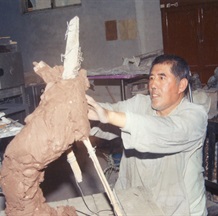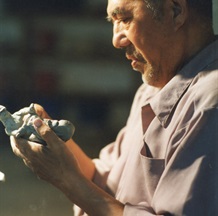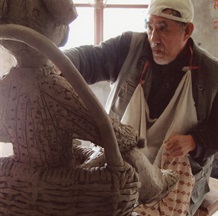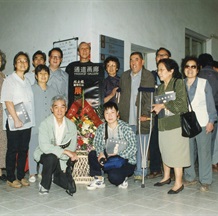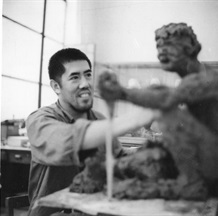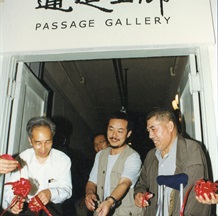Liu Shiming was born in 1926. Our first impression of him is: his long face, dark eyebrows, round eyes, crippled legs, taciturnity, and engaging smile.
Who is Liu Shiming? In search of historical facts of modern Chinese sculptures, we find his name is associated with many big events. First of all, his early work “Measuring the Land” created during his student’s era, is the first Chinese sculptural work which was exhibited abroad and collected by the National Museum of former Republic of Czechslovakia; In 1953, as an assistant, he took part in the making of the Monument of the People’s Heroes on the Tiananmen Square; In 1959, his work “Removing the Mountains, Diverging the Rivers” was presented at a grand art show for plastic art works by socialist countries held in the former Soviet Union.
Is Liu a good teacher? He did not teach us the realistic themes of monumental sculptures in the classrooms of the central academy; he did not teach us the spatial compositions of human nudes either. But we, however, call him “Teacher.”
Is Liu a hermit? He rides a tricycle all year round; he hymns tunes from local operas that are strange to us younger artists; he likes to spend time in parks near the Forbidden City. And those are our impressions of him. Since 1995 when he turned 70, we have rarely seen him because of the relocation of the Central Academy of Fine Arts.
Is Liu a good friend of ours? He never takes the initiative in talking to you; he hardly gives any instructions as if he were in a classroom; he never engages himself in our discussions about topics of common concern. But he as a rule shows his sincerity with his works.
Is Liu a stranger? He enjoys no status of scholar nor does, he show off his personal experience. Nor does he like to go after trends. But he has drawn a lot of fans who admire his artistic creation and skills.
Lu Shiming is unique. He has a unique identity; he is unique in his interest; he is unique in his artistic pursuit; he is, too, unique in his artistic creations. Liu and his art are so unique that they both deserve closer look by scholars.
Liu’s first few exhibits were shown to the public at the Corridor Gallery in 1998 organized by the Sculpture Department of the academy and his latest creations, all his works are included in this pictorial.
Centering on Liu and his art, the book is aimed to give a realistic presentation of the development of China’s modern and contemporary sculptural art. And in this context, Liu and his art is probed and displayed in terms of its spiritual and personal significances. Studies on Liu and his sculptural art is a vital part of the academic researches of the institute and the academy on modern and contemporary Chinese sculptural artists.
With depth and width studies on his personal case has been made by the Sculptural Art Creation Research Institute on Liu Shiming and his art.
The featured essays and papers in this book are based on the close attention paid by artists, researchers, and critics including Jin Shangyi, Shao Dazhen, Zou Peizhu, Hou Yimin, Qian Shaowu, Jin Zhilin, Yang Xianrang, Yuan Yunsheng, Yuan Zhengming, Wu Jing, liu Jiahong, Yu xinag, Sheng Yang, Cao Chunsheng, Situ Zhaoguang, Dong Zuyi, Li Xiangsheng, Wang Jingdong, Li Zhenxiang, Xie Jiasheng, Sun Jiabo, Yang Li, Fan Di’an, Tan Ping, Sui Jianguo, Yin Shuangxi, Sun Zhenhua, Weng Yunpeng, Zhao Jiaying, Li Zhitan, Wang Fuchao, Fu Jinkai, Wang Fuquang, Zhou Heping, Wang Bangyan, Wang Wei, Ding Zhongyi, Li Baogui, Zhu Xike, Yu Xiaoping, Chao Ziwei, Zhu Bo, Lu Pinchang, and Duan Haikang.
The book is a component of the case study on Liu and his art with Yin Shuangxi as the academic editor. As the chief editor, he has also made minute and strenuous efforts to complete the selection of the photos and editing of the essays.
In his paper, Yin Shuangxi pointed out that we now should rethink whether there exists a set of criteria and standards for the judgment of contemporary Chinese sculptural art. He says that the criteria and the standards are closely associated with the taking in of traditional Chinese culture, art as well as the transformation in modern times.
He holds that Liu has made great contribution to this subject with his lifetime efforts, predicting that“people will have a clear vision of this historic mission through the art exhibition to be staged in October 2006 by the Central Academy of Fine Arts.”
The continued research on Liu’s art broadens our horizon. We have come to see a great varieties of ways in the development of Chinese sculptural art; starting from local culture, we also see it is one of the extremely valuable ways.
Today, we put together the pictures of Liu’s works into this album. But this is just the beginning of our research. It is not the right time for us to come to any conclusion on Liu’s art; as time goes on case study on Liu’s sculptural art would be carried out further and deeper. We believe Liu and his art will help create a new world for Chinese arts and culture as a whole.
As the postscript to the album for Liu Shiming’s art show, thanks shall first go to Liu whose life-time commitment makes it a reality for us to study Chinese sculptural art in a new light.
We would also like to pay our respect to Central Academy of Fine Arts, the past and the present ones. It is at this academy that Liu Shiming carved out himself as an excellent artist. We would like to show our respect for Henan and Hebei provinces, the National Museum of China, where Liu spent fruitful years and honed his skills in sculptural art.
It is with warm support also from these people and institutions that the publication of this album is made possible: the National Art Museum of China, the People’s Publishing House of Fine Arts, China Sculpture Art Society, Shao Dazhen, Qian Shaowu, Cao Chunsheng, Sun Jiabo. I would also like to thank Hu Ke and Luo Xianguo for their devotion to the detailed and sometimes trivial work during the compiling of this album.
Finally, I would like to express my heartfelt thanks to Liu Shiming and his family for their warm support though his wife Hao Shuyuan is in weak health. Special thanks should go to Liu Wei, son of Liu Shiming, who has born sensitivity for art and has supported the compilation and publication of whole-heartedly.
Liu Shiming is unique in his identity, his interest, his personality, his artistic concern and his art works. Liu Shiming, a man who deserves our study, needs attention from the artists community, and individuals and the general public as well. The publication of the book provides us a platform to re-discover and to study Liu and his art. Let us step into Liu Shiming’s artistic world and in doing so we may find new possibilities for Chinese sculpture art in the 21st century.
Sun Wei, director of the Sculptural Art Creation Research Institute, Central Academy of Fine Arts


